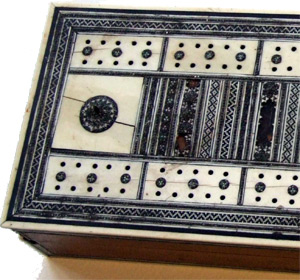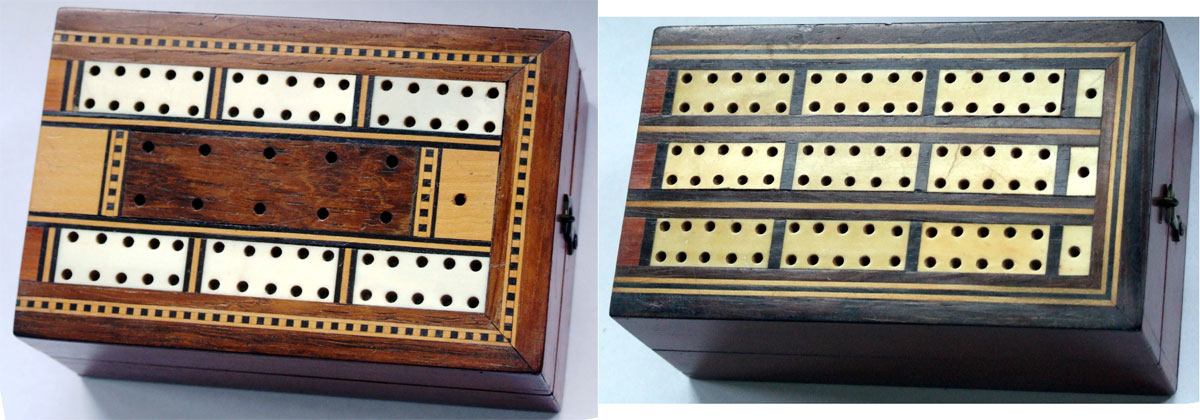Cribbage Board Collection
A collection of antique and vintage Cribbage Boards by Tony Hall

by Tony Hall
Cribbage was invented in the first half of the 17th Century but its heyday in Britain was probably from around the 1850s until the 1940s when parlour games were the main source of domestic entertainment. The game is still played in the UK in pubs and there are (apparently) local leagues playing both the five and six card version of the game. It is even more thriving in the States, being initially the game of choice in the US Navy, particularly in submarines for obvious reasons, and there is a National Association concerned with both play and board collection. I have a wide variety of cribbage boards in my collection of varying ages and interest. Some have significant age and specifications, a few are quite rare. Most of the boards date from the heyday of crib in Britain, although there are some earlier, some later. Most are commercially made; a few are shed work of varying qualities and interest.
However, the bulk of the collection is Victorian/Edwardian. Many of the single box and double box boards date from the 1880s to the 1920s. For example, the two and three-player single box boards (shown below). Both are commercially made from multiple woods and veneers, with bone or plastic inlays. Each has space for one pack of cards and a separate compartment for four or six bone or ivory pegs.

Above: single and double box cribbage boards. From the collection of Tony Hall.
In later years (in the 30s and 40s), many boards were produced for advertising drink or cigarettes.

Above: rare example of single cribbage box with advertising, offering the Season’s Greetings from the Criterion chain of wine and spirit shops operating (judging by the street names) throughout the Birmingham area. The design suggests any time from 1900-1920. From the collection of Tony Hall.
It is not unusual to find a single box in the shape of a horseshoe, although most also have a brass fan of four Ace cards in the centre (missing from this example). But my most exotic single box is made by Gulum Hussan, Kashmere, India and was probably used by the Brits during the Raj and found its way later to England (see below).

Above: single box cribbage boards, a) horseshoe shaped, b) made in India by by Gulum Hussan, Kashmere. From the collection of Tony Hall.
Most double boxes are commercially made to cater for two players, with two packs of cards and a central compartment for pegs and counters. They vary in quality from the highly polished veneered Victorian examples to more basic versions from the same period.

Above: two double box cribbage boards varying in quality from the highly polished veneered Victorian example and a more basic version from the same period. From the collection of Tony Hall.


By Tony Hall
Member since January 30, 2015
I started my interest in card games about 70 years ago, playing cribbage with my grandfather. Collecting card game materials started 50 years or so later, when time permitted. One cribbage board was a memory; two became the start of a collection currently exceeding 150!
Once interest in the social history of card games was sparked, I bought a wooden whist marker from the 1880s which was ingenious in design and unbelievably tactile. One lead to two and there was no stopping.
What happened thereafter is reflected in my articles and downloads on this site, for which I will be eternally grateful.
Related Articles

Victorian grocer’s scale plate
Large flat plate decorated with highly coloured English cards and royal arms.

Queen of Arts
A wide variety of women artists celebrated on cards with illustrations by Laura Callaghan.

The Glasgow Pack
Issued to celebrate Glasgow’s reign as European City of Culture in 1990, with city views and works o...

Cathedrals, Abbeys & Minsters playing cards
54 pictures of different famous cathedrals, abbeys and minsters in England and Wales.

Christmas Carols
Christmas Carols playing cards illustrated by Stuart Dilks

Pam is the Knave of Clubs
Playing cards as metaphors in 18th century art - from fate, chance and social hierarchy t...

Question and Answer Games
A card game called “Impertinent Questions and Pertinent Answers” was launched in the early 1920s by ...

Dr Sacheverell
Dr. Henry Sacheverell's impeachment in 1710 sparked widespread public unrest and political upheaval,...

Leadmill playing cards
Promotional pack for an arts centre in Sheffield with designs by Martin F. Bedford.

Agatha Christie and card games
Agatha Christie uses card-play as a primary focus of a story, and as a way of creating plots and mot...

English Heritage
52 different colour photos of historic sites managed by English Heritage.

The Malt Whiskies of Scotland
Three packs featuring photographs by Duncan McEwan of malt whisky distilleries in Scotland.

Typographic Playing Cards
Typographic Playing Cards designed by Jim Sutherland, c.2010.

76: Transitions: Hunt & Sons
Styles change and technology develops. This means that it's possible to see transition periods in th...

Gibson’s History of England
History without tears for young and old, 1920s.

Simpson (Piccadilly) playing cards
Innovative advertising pack for Simpsons of Piccadilly designed by André François.
Trending Articles
Popular articles from the past 28 days







